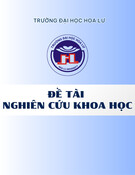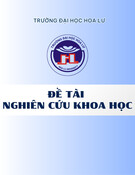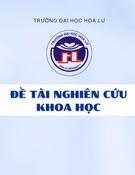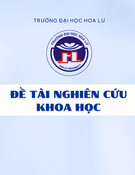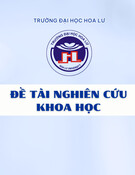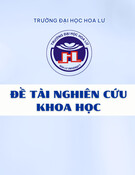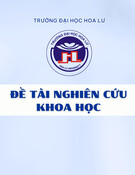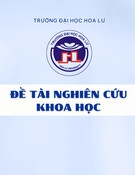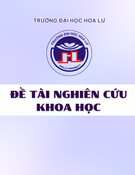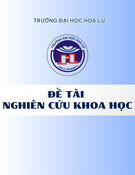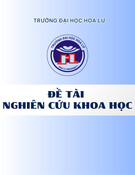
H.T.T.Hai, C.T.T. Lam, T.D.Thang, N.X.Dung Chemical composition ..., TR. 42-46
42
Chemical composition of the fruit oil of
Michelia sp.
from Vietnam - A New Natural Source of Safrole
Ha Thi Thanh Hai
(a)
, Chu Thi Thanh Lam
(a)
,
Tran Dinh Thang
(b)
, Nguyen Xuan Dung
(c)
Abstract. The volatile components of the fruit oil of Michelia sp. from Nghean
province, were analysed by Capillary Gas chromatograph (GC) and Gas
chromatograph/Mass spectroscopy (GC/MS) as well as by background subtraction of
coeluting compounds.
A total 33 compounds were identified of which the major component was safrole
(93.41%). The lesser amount were limonene (1.19%) and linalool (2.46%). This result
shows that Michelia sp. from Nghe an as a new source of safrole.
1. Introduction
The Magnoliaceae contains about 15 genera and ca. 300 species most of the
species occur primarily in East and South-East Asia but also in South-East North
America, and tropical America. There are 50 species of the genus Michelia
distributed in tropical and subtropical Asia [1].
Michelia species are commonly cultivated for their fragrant flowers and as
ornamentals. The flowers of some Michelia are marketed for their scent, used in
making garlands, placed between stored clothes, sprinkled in bridal beds and used
in the preparation of scented hair lotions. In Thailand an infusion of the flowers is
applied as a cosmetic after bathing. In Indonesia an infusion made by steeping the
bitter bark in water is given against fever. Several Michelia species, yield a timber
of minor economic importance, used for light construction, vehicle bodies, packing
cases and for the production of veneer plywood, wood-wood board and as fuel [2].
M. balansae (A.DC.) Dandy is an ornamental tree planted in gardens and
growing wild. The flower is beautiful and fragrant and can be used for the extraction
of essential oil. Only one report on flower oil components of this species. Chemical
constituents of the flower oil of M. balansae (A.DC.) Dandy from South China
Botanical Garden, Guangzhou are as follows: butyl acetate (2.18%), ethyl butyrate
(0.23%), 1- ethoxyethyl acetate (0.60%), ethyl 2-methylbutyrate (0.43%), 2-
methylbutyl acetate (2.80%), 2-metylpropyl 2-methylpropanoate (1.86%), methyl
hexanoate (0.21%), α-pinene (0.12%), 1-metylpropyl butyrate (0.34%), β-pinene
(0.10%), β-myrcene (0.10%), ethyl hexanoate (61.01%), 2-methylpropyl 3-butyrate
(0.17), 2-methylbutyl 2-metyl 2-metylpropanote (0.10%), p-cymene (0.42%), limonene
(15.70%) ethyl 2-hexenoate (0.10%), camphor (0.27%), 2-methylpropylhexanoate
(1.32%), and carvone (0.10%) [3].
The volatile components of the leaf oil of M. balansae (A.DC.) Dandy from the
Nghean province, Vietnam were analyzed by Capillary GC, GC/MS as well as by
background substraction of coeluting compounds. The major components in the leaf
.
NhËn bµi ngµy 29/5/2008. Söa ch÷a xong 28/10/2008.

tr−êng §¹i häc Vinh T¹p chÝ khoa häc, tËp XXXVII, sè 4a-2008
43
oil were α-pinene (18.41%), α-, β-phellandrene (17.36% and 7.42%), germacrene D
(17.98%) and bicyclogermacrene (7.55%). The lesser amounts were β-myrcene
(3.88%), δ-elemene (5.11%) and β-caryophyllene (3.47%) [4].
The leaf oil of M. montana from India were prepared by hydrodistillation and
analysed by a combination of GC and GC/MS. Thirty components have been
identified. The major constituents were found to be asaricin (81.8%) and safrole
(13.0%) [5].
The essential oil in Michelia leaves was extracted by steam distillation. The
oil obtained was dried with anhydrous magnesium sulfate. Thirty three peaks were
separated by GC, and 27 of them were identified by MS with NBS mass spectral
data and Wiley/NBS registry of mass spectral data. The structure of linalool was
further verified by GC/FTIR. The identified constituents represent 97% of the peak
area of the essential oil on FID. The major chemical constituent of them are linalool,
trans-caryophyllene and diethyl-o-phthalate [6].
In the course of the systematic study of Michelia from Indochina, mono-,
sesquiterpenes and other components of the fruit oil of Michelia sp. from Nghean
province have been investigated.
2. Experimental
Source: Fruits of Michelia sp. were collected in Pu Huong National Park,
Nghean province. A voucher specimen (NLN5) is deposited at the Herbarium of the
Institute of Ecology and Biological Resources, Vietname Academy of Science and
Technology.
Dried fruits were shredded and their oil were obtained by steam distillation
for 3h at normal pressure, according to the Vietname Pharmacopoeia [7]. The yield
of the fruit dried oil is 0.20%.
GC- About 15mg of oil, which was dried with anhydrous sodium sulfate, was
dissolved in 1ml of n-hexane (for spectroscopy or chromatography).
GC analysis was performed on a Agilent Technologies HP 6890 Plus Gas
chromatograph equipped with a FID and fitted with HP-5MS column (L=30m,
ID=0.25mm, film thickness =0.25µm). The analytical conditions were: carrier gas
H
2
, injector temperature (PTV) 250
o
C, detector temperature 260
o
C, column
temperature programmed 60
o
(2 min hold) to 220
o
(10 min hold) at 4
o
C/min.
GC/MS- An Agilent Technologies HP 6890N Plus Chromatograph was fitted
with a fused silica capillary column HP-5 MS column (L=30m, ID = 0.25mm, film
thickness =0.25µm). The conditions of use were the same as described above with He
as carrier gas, and interface with a mass spectrometer HP 5973 MSD (70eV). The
temperature was programmed as reported above. Components identification was
carried out by comparing MS data with those reported in Library Willey on
Chemstation HP [8, 9].
3. Results and discussion
Thirty-three compounds identified in the fruit oil of Michelia sp. from
Vietnam are listed in Table 1 together with their experimental Kovats indices and

H.T.T.Hai, C.T.T. Lam, T.D.Thang, N.X.Dung Chemical composition ..., TR. 42-46
44
relative peak areas.
Table 1: The chemical composition of the fruit oil of Michelia sp. from Vietnam
No Compounds KI %FID
1
α-pinene 939 trace
2
fenchene 953 trace
3
β-pinene 980 0.10
4
myrcene 990 0.23
5
δ-3-carene 1011 0.50
6
p-cymene 1026 0.13
7
limonene 1032 1.19
8
(Z)-β-ocimene 1043 0.69
9
(E)-β-ocimene 1052 trace
10
(Z)-linalool oxide (furanoid) 1063 trace
11
α-terpinolene 1088 trace
12
rosefuran 1091 trace
13
linalool 1100 2.46
14
allo-ocimene 1132 trace
15
p-mentha-1,5-dien-8-ol 1166 trace
16
p-cymen-8-ol (1167-1183) 1176 trace
17
α-terpineol 1179 trace
18
safrole 1287 93.42
19
piperonal 1332 trace
20
eugenol 1359 0.16
21
α-copaene 1376 trace
22
methyleugenol 1407 trace
23
α-gurjunene 1410 trace
24
β-caryophyllene 1419 0.10
25
γ-elemene 1443 trace
26
β-selinene 1473 trace
27
germacrene D 1480 trace
28
δ-cadinene 1525 trace
29
α-calacorene 1530 trace
30
spathulenol 1576 0.18
31
caryophyllene oxide 1581 0.12
32
isopathulenol 1638 trace
33
vulgarol B 1647 trace
The results of the analysis demonstrate that approximately (99.00%) (33
compounds) of the essential oil were identified. The fruit oil of Michelia was
composed mainly of oxygenated compounds (96.34 %). The major component was
safrole (93.42%) other compounds present in significant amounts were limonene
(1.19%) and linalool (2.46%).
The monoterpene hydrocarbons and sesquiterpene hydrocarbons contain
small amounts (2.84%, 0.10%). The mixture of the oxygenated compounds such as
(Z)-linalool oxide (trace), rosefuran (trace), linalool (2.46%), allo ocimene (trace), p-

tr−êng §¹i häc Vinh T¹p chÝ khoa häc, tËp XXXVII, sè 4a-2008
45
metha-1,5-dien-8-ol (trace), p-cymen-8-ol (trace), α-terpineol (trace), safrole (93.42%)
piperonal (trace), eugenol (0.16%), methyleugenol (trace), spathulenol (0.18%),
caryophyllene oxide (0.12%), isospathulenol (trace) and vulgarol B (trace) furnisches
the typical odor impressions.
Safrole is an important raw material for the chemical industry because of
two derivatives: heliotropin, which is widely used as a fragrance and flavoring
agent, and piperonyl butoxide, a vital ingredient of pyrethroid insecticides. Safrole
has many fragrance applications in household products such as floor waxes,
polishes, soaps, detergents, and cleaning agents.
The source of safrole in the 20
th
century was Ocotea pretiosa from Brazil,
Colombia and Paraguay [10]. This was based on a discovery in l939 that wood
distillation from a large tree in the state of Santa Catarina yielded a rich source of
sassafras oil, containing 84.0% safrole. At the end of last century (in the early
1990s), certain forest shrubs of the Piperaceae such as P. hispidinervum, P.
callosum and P. callosum, indigenous to the humid forests of Central America and
Greater Amazonia, were found to contain high levels of safrole in their leaves. The
safrole content of the oil in unselected stock is about 85%, but a improvement to
more than 90% is possible through selection. Leaves of P. hispidinervum in
experimental plots contained 3% essential oils of which 93% is safrole [11]. Since
90
th
decace of the 20 century, China and Vietnam has been exporters of sassafras oil,
from wild and cultivate trees of Cinnamomum camphora and C. parthenoxylon
(Jack) Nees [12].
Forest preservation in developing countries is a controversial issue that
involves many different interests. The worldwide demand for raw materials, such as
safrole, offers an opportunity to these countries that have a source of products in
their natural forests. Forest preservation is best linked to local populations
maintenance. In this context, Michelia sp. is more than a new safrole source.
Since this species occurs in low populations in several areas, we have plant to
cultivate this species for sustainable demand of safrole and assist in the
maintenance of the rainforest of Vietnam. An integrated project based on this
species among research institutes, universities, governmental, and non-
governmental institutions could produce a sustainable alternative crop for the
tropical rainforest.
Acknowledgements: The Authors wish to thank Dr. B. M. Lawrence,
Editor in Chief of the Journal of Essential Oil Research (USA) for his support in
literature.
References
[1] Wu. Z. & Peter H. R. (eds). Flora of China. Vol. 7 (Berberidaceae through
Capparaceae). Science Press, Beijing, and Missouri Botanical Garden Press, St.
Louis. In Preparation.

H.T.T.Hai, C.T.T. Lam, T.D.Thang, N.X.Dung Chemical composition ..., TR. 42-46
46
[2] Oyen L.P.A. and Dung N. X. (Editors), Plant Resources of South East Asia, N
o
19,
Essential Oil Plants, Backhuys Publishers, Leiden, the Netherlands, 1999.
[3] Zhu Liangfeng et al., Aromatic Plants and Essential Constituents, Hai Feng
Publishing Co., Hong Kong, 1993.
[4] Dung N. A, Thang T. D. and Dung N. X., Chemical Composition of the Leaf Oil of
Michelia balansae (A.DC.) Dandy from Vietnam, Journal of Essential Oil
Bearing Plants, 8 (1), 2005, 11-15.
[5] Genderen V., Marcel H.P., Leclercq P. A., Delgado H. S., Kanjilal P. B., Singh R.
S., Compositional analysis of the leaf oils of Piper callosum Ruiz & Pav. from
Peru and Michelia montana Blume from India, Spectroscopy, 14 (2), 1999, 51-59.
[6] Qin C., Lu Z. Chen K., Study on chemical constituents of essential oil of Michelia
leaves by gas chromatography-mass spectrometry, SePu, 17(1), 1999, 40-42.
[7] Vietnamese Pharmacopoeia, Medical Publishing House, Hanoi (1997).
[8] Adams R. P., Identification of Essential Oil Components by Gas
Chromatography/Quadrupole Mass Spectrometry. Allured Publishing Corp.
Carol Stream, IL, 2001.
[9] Joulain D. and Koenig W. A., The Atlas of Spectral Data of Sesquiterpene
Hydrocarbons. E. B. Verlag, Hamburg, 1998.
[10] Rizzini, C.T. and W.B. Mors, Botancia economica brasileira. 2nd ed. Ambito
Cultural, Rio de Janeiro, RJ, 1995.
[11] Rocha S. F. R. and Ming L. C., Piper hispidinervium: A Sustainable source of
safrole. In: Janick, J. (ed.), Perspectives on New Crops and New Uses. ASHS
Press, Alexandria, Virginia, 1999, 479–481.
[12] Dung N. X., Moi L. D, and Leclercq P. A., Consituents of the Essential Oils of
Cinamomum parthenoxylon (Jack) Ness (Family Lauraceae) from Vietnam, J. of
Essential Oil Research (USA) 7, 1995, 53-57.
Tãm t¾t
Thµnh phÇn ho¸ häc cña tinh dÇu qu¶ loµi giæi (Michelia sp.) ë
ViÖt Nam - mét nguån cung cÊp safrol
Thµnh phÇn ho¸ häc cña tinh dÇu qu¶ loµi giæi (Michelia sp.) ë NghÖ An, ®−îc
ph©n tÝch b»ng ph−¬ng ph¸p s¾c ký khÝ (GC) vµ s¾c ký khÝ-khèi phæ (GC-MS). Ba
m−¬i ba hîp chÊt ®−îc x¸c ®Þnh, víi thµnh phÇn chÝnh lµ safrol (93,41%). C¸c hîp
chÊt cã hµm l−îng t−¬ng ®èi lín lµ limonen (1,19%) vµ linalool (2,46%). KÕt qu¶ nµy
cho thÊy loµi giæi (Michelia sp.) ë NghÖ An lµ mét nguån míi cung cÊp safrol.
(a)
Faculty of Agriculture, Forestry and Fisheries, Vinh University
(b)
Faculty of Chemistry, Vinh University
(c)
Faculty of Chemistry, College of Natural Science, Hanoi National
University.

